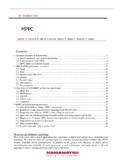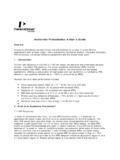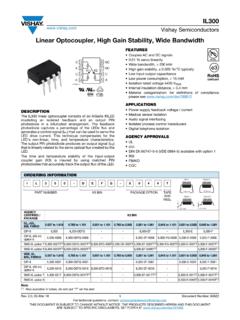Transcription of Application circuit examples - Hamamatsu Photonics
1 Si Photodiodes42 Extracting the photodiode signal from the cathode terminal is another effective means. An effective countermeasure against AC noise from the power supply is inserting an RC filter or an LC filter in the power supply line. Using a dry cell battery as the power supply also proves effective way. Op amp noise can be reduced by selecting an op amp having a low 1/f noise and low equivalent input noise current. Moreover, high-frequency noise can be reduced by using a feedback capacitor (Cf) to limit the cir-cuit frequency range to match the signal frequency errors (due to the op amp input bias current and input offset voltage, routing of the circuit wiring, circuit board sur-face leak current, etc.)
2 Should be reduced, next. A FET input op amp with input bias currents below a few hundred fA or CMOS input op amp with low 1/f noise are selected. Using an op amp with input offset voltages below several millivolts and an offset adjustment terminal will prove effective. Also try us-ing a circuit board made from material having high insulation resistance. As countermeasures against current leakage from the surface of the circuit board, try using a guard pattern or el-evated wiring with teflon terminals for the wiring from the pho-todiode to op amp input terminals and also for the feedback resistor (Rf) and feedback capacitor (Cf) in the input offers the C6386-01, C9051 and C9329 photosen-sor amplifiers optimized for use with photodiodes for low-light-level photodiodes, and coaxial cables with BNC-to-BNCplugs are sold lines should be within guarded pattern or on teflon : AD549, OPA124, : OP07, : 10 pF to 100 pF, polystyrene capacitorRf : 10 G : Low-leakage reed relay, switchPD.
3 S1226/S1336/S2386 series, S2281, = Isc Rf [V]Low-light-level detection circuitLow-light-level detection circuits require measures for reducing electromagnetic noise in the surrounding area, AC noise from the power supply, and internal op amp noise, 4 shows one measure for reducing electromagnetic noise in the surrounding 4 Low-light-level sensor headMetal packagePDShieldedcableBNCcoaxialcable, ++5 V-5 V0 CfRf2Rf1SW1SW210-turnpotentiometer10 10 ++IC2-+1 Metal shielded box KSPDC0051EC(a) example using shielded cable to connect to photodiodePDVoIC1-++5 V-5 V0 CfRf2Rf1SW1SW210-turnpotentiometer10 10 ++IC2-+Metal shielded boxISC KSPDC0052EB(b) example using metal shielded box that contains entire circuitPDOptical fiberVoIC1-++5 V-5 V0 CfRf2Rf1SW1SW210-turnpotentiometer10 10 ++IC2-+Metal shielded boxISC KSPDC0053EB(c) example using optical fiberFigure 5 Photosensor amplifiers(a) C6386-01(b) C9051(c) C9329 Light-to-logarithmic-voltage conversion circuitThe voltage output from a light-to-logarithmic voltage conver-sion circuit (Figure 6) is proportional to the logarithmic change in the detected light level.
4 The log diode D for logarithmic conversion should have low dark current and low series resis-tance. A Base-Emitter junction of small signal transistors or Gate-Source junction of connection type of FETs can also be used as the diode. IB is the current source that supplies bias current to the log diode D and sets the circuit operating point. Unless this IB current is supplied, the circuit will latch up when the photodiode short circuit current ISC becomes +-+15 VPD-15 VVoDICRIscIBIoD : Diode of low dark current and low series resistanceIB : Current source for setting circuit operation point, IB << I s cR : 1 G to 10 G Io : D saturation current, 10-15 to 10-12 AIC : FET-input Op amp, log ( + 1) [V] Isc + IBIoFigure 6 Light-to-logarithmic-voltage conversion circuitLight integration circuitThis is a light integration circuit using integration circuits of photodiode and op amp and is used to measure the integrated power or average power of a light pulse train with an erratic pulse height, cycle and integrator IC in the figure 7 accumulates short circuit cur-rent Isc generated by each light pulse in the integration capaci- Application circuit examples43Si Photodiodes+-+15 VPD-15 VVO4610 kIC1 k+15 V327142SW11 kC137 Reset inputVOResetinputIscttttoIscReset input: Use TTL L to : LF356, : CMOS 4066PD : S1226/S1336/S2386 series.
5 Polycarbonate capacitor, = Isc to [V]1 CKPDC0027 EBFigure 7 Light integration circuitBasic illuminometer (1)A basic illuminometer circuit can be configured by using Hama-matsu C9329 photosensor amplifier and S9219 Si photodiode with sensitivity corrected to match human eye response. As shown in Figure 8, this circuit can measure illuminance up to a maximum of 1000 lx by connecting the output of the C9329 to a voltmeter in the 1 V range via an external resistive voltage standard light source is normally used to calibrate this circuit , but if not available, then a simple calibration can be performed with a 100 W white light calibrate this circuit , first select the L range on the C9329 and then turn the variable resistor VR clockwise until it stops.
6 Block the light to the S9219 while in this state, and rotate the zero adjusting volume control on the C9329 so that the voltme-ter reads 0 mV. Next turn on the white light source, and adjust the distance between the white light source and the S9219 so that the voltmeter display shows V. (The illuminance on the S9219 surface at this time is approximately 100 lx.) Then turn the VR counterclockwise until the voltmeter display shows V. The calibration is now calibration, the output should be 1 mV/lx in the L range, and 100 mV/lx in the M range on the kCWPhotosensoramplifierExternally connected voltage divider circuitC9329 Coaxial cableE2573VR1 k500 VISCPD: S9219 ( A/100 lx)Figure 8 Basic illuminometer (1)Basic illuminometer (2)This is an basic illuminometer circuit using a visual-compensat-ed Si photodiode S7686 and an op amp.
7 A maximum of 10000 lx can be measured with a voltmeter having a 1 V range. It is necessary to use a low consumption current type op amp which can operate from a single voltage supply with a low in-put bias current. An incandescent lamp of 100 W can be used for approximate calibrations in the same way as shown above Basic illuminom-eter (1) . To make calibrations, first select the 10 mV/lx range and short the wiper terminal of the variable resistor VR and the output terminal of the op amp. Adjust the distance between the photodiode S7686 and the incandescent lamp so that the voltmeter reads V. (At this point, illuminance on S7686 surface is about 100 lx.) Then adjust VR so that the voltmeter reads V.
8 Calibration has now been p1 k1 kPD10 k100 k1 M006 p(9 V) mV/lx1 mV/lx10 mV/lxIC+-IscVVR: Meter calibration trimmer potentiometerIC : TLC271, : S7686 ( A/100 lx)KPDC0018 EDFigure 9 Basic illuminometer (2)Light balance detection circuitFigure 10 shows a light balance detector circuit utilizing two si photodiodes PD1 and PD2 connected in reverse-parallel and an op amp current-voltage converter circuit . The photoelectric sensitivity is determined by the feedback resistance Rf. The output voltage Vo of this circuit is zero if the amount of light entering the two photodiodes PD1 and PD2 is equal. By placing two diodes D in reverse parallel with each other, Vo will be limited range to about V in an unbal-anced state, so that the region around a balanced state can be detected with high sensitivity.
9 This circuit can be used for light balance detection between two specific wavelengths using op-tical +ISC2 ISC1PD2PD1 RfDD23764-15 V+15 VVoICPD: S1226/S1336/S2386 series, : LF356, : ISS226, etc. Vo = Rf (Isc2 - Isc1) [V](Vo< V)KPDC0017 EBFigure 10 Light balance detection circuittance C. By measuring the output voltage Vo immediately before reset, the average short circuit current can be obtained from the integration time (to) and the capacitance C. A low dielectric ab-sorption type capacitor should be used as the capacitance C to eliminate reset errors. The switch SW is a CMOS analog Photodiodes44 Light absorption meterThis is a light absorption meter using a dedicated IC and two photodiodes which provides a logarithmic ratio of two current inputs (See Figure 11).
10 By measuring and comparing the light intensity from a light source and the light intensity after trans-mitting through a sample with two photodiodes, light absor-bance by the sample can be make measurements, optical system such as the incident aperture should first be adjusted to become the output volt-age Vo to 0 V so that the short circuit current from the two si photodiodes is equal. Next, the sample is placed on the light path of one photodiode . At this point, the output voltage value means the absorbance by the sample. The relationship be-tween the absorbance A and the output voltage Vo can be di-rectly read as A=-Vo [V]. If a filter is interposed before the light source as shown in the figure 11, the absorbance of specific light spectrum or monochromatic light can be measured.











